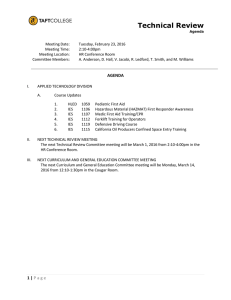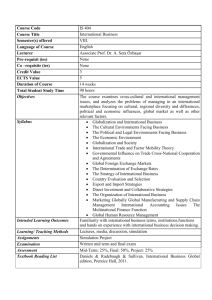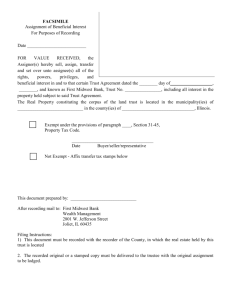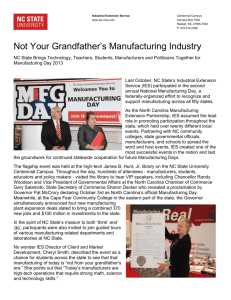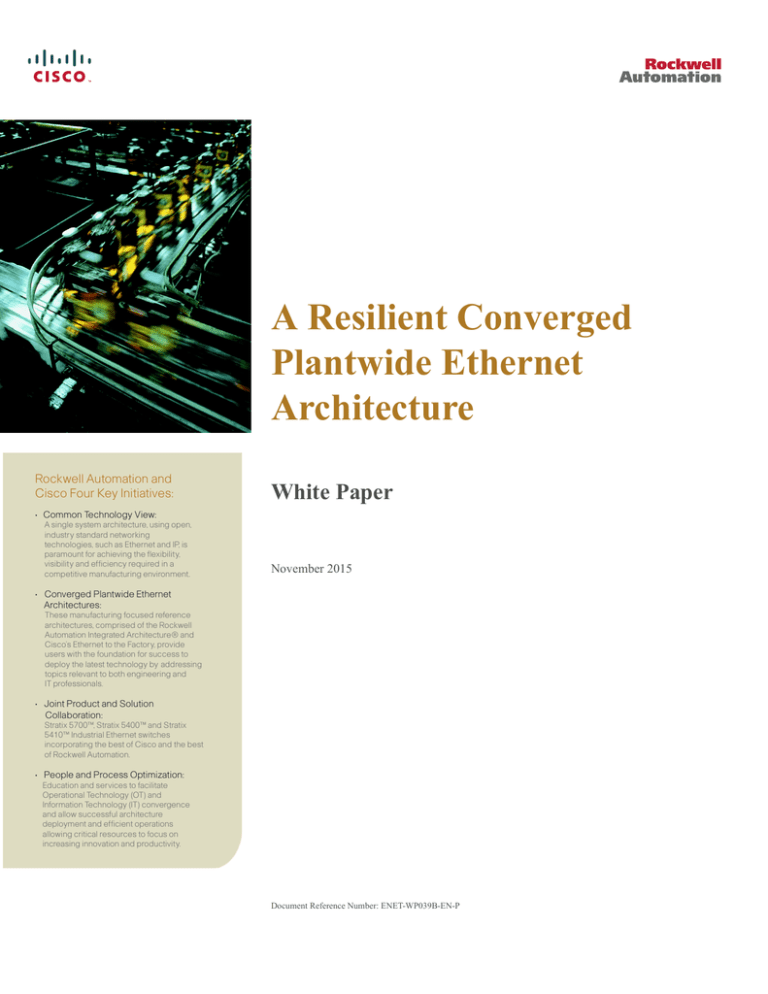
A Resilient Converged
Plantwide Ethernet
Architecture
Rockwell Automation and
Cisco Four Key Initiatives:
White Paper
• Common Technology View:
A single system architecture, using open,
industry standard networking
technologies, such as Ethernet and IP, is
paramount for achieving the flexibility,
visibility and efficiency required in a
competitive manufacturing environment.
November 2015
• Converged Plantwide Ethernet
Architectures:
These manufacturing focused reference
architectures, comprised of the Rockwell
Automation Integrated Architecture® and
Cisco’s Ethernet to the Factory, provide
users with the foundation for success to
deploy the latest technology by addressing
topics relevant to both engineering and
IT professionals.
• Joint Product and Solution
Collaboration:
Stratix 5700™, Stratix 5400™ and Stratix
5410™ Industrial Ethernet switches
incorporating the best of Cisco and the best
of Rockwell Automation.
• People and Process Optimization:
Education and services to facilitate
Operational Technology (OT) and
Information Technology (IT) convergence
and allow successful architecture
deployment and efficient operations
allowing critical resources to focus on
increasing innovation and productivity.
Document Reference Number: ENET-WP039B-EN-P
A Resilient Converged Plantwide Ethernet
Architecture
Business practices, corporate standards, industry standards, policies and tolerance to risk are key factors in
determining the degree of resiliency and application availability required within a plant-wide architecture. A
resilient network architecture within an Industrial Automation and Control System (IACS) application plays
a pivotal role in helping to minimize the risk of application shutdowns while helping to maximize overall
plant uptime.
An IACS is deployed in a wide variety of industries such as automotive, pharmaceuticals, consumer goods,
pulp and paper, oil and gas, mining and energy. IACS applications are made up of multiple control and
information disciplines such as continuous process, batch, discrete and hybrid combinations. A resilient
network architecture can help to increase overall equipment effectiveness (OEE) of the IACS by reducing the
impact of a failure and speed recovery from an outage which lowers mean-time-to-repair (MTTR).
A holistic resilient plant-wide network architecture is made up of multiple technologies (logical and physical)
deployed at different levels within the plant:
•
Robust physical infrastructure
•
Topologies and protocols
•
Switching and routing
•
Wireless LAN Controllers (WLC)
•
Firewalls
•
Network and device management
Converged Plantwide Ethernet (CPwE) is the underlying architecture that provides standard network services
for control and information disciplines, devices and equipment found in modern IACS applications. The
CPwE architecture (Figure 1) provides design and implementation guidance to achieve the real-time
communication, reliability, scalability, security and resiliency requirements of the IACS.
CPwE Resiliency for IACS applications is brought to market through a strategic alliance between Cisco
Systems® and Rockwell Automation.
A Resilient Converged Plantwide Ethernet Architecture
ENET-WP039B-EN-P
1
A Resilient Converged Plantwide Ethernet Architecture
Converged Plantwide Ethernet Resiliency
Figure 1
CPwE Architectures
Wide Area Network (WAN)
Internet
Enterprise
Physical or Virtualized Servers
External DMZ/
Firewall
ERP - Business Systems
Email, Web Services
Security Services - Active Directory (AD), Identity Services (AAA)
Network Services – DNS, DHCP
Call Manager
Enterprise Zone
Levels 4 and 5
Plant Firewalls
Physical or Virtualized Servers
•
•
•
•
•
•
•
•
•
Patch Management
AV Server
Application Mirror
Remote Desktop Gateway Server
• FactoryTalk Application Servers and
Services Platform
• Network & Security Services – DNS,
AD, DHCP, Identity Services (AAA)
• Storage Array
Industrial Zone
Levels 0–3
Distribution
Switch Stack
Active
Wireless
LAN Controller
(WLC)
Remote
Access
Server
Level 3 - Site Operations
Standby
(Control Room)
Industrial
Demilitarized Zone
(IDMZ)
Core
Switches
RADIUS
(AAA) Server
Physical or Virtualized Servers
Active/Standby
Inter-zone traffic segmentation
ACLs, IPS and IDS
VPN Services
Portal and Remote Desktop Services proxy
Cell/Area Zone
Levels 0–2
Distribution
Switch Stack
Cell/Area Zone
Levels 0–2
LWAP
AP
CAPWAP
IES
Camera
IES
LWAP
IES
LWAP
CAPWAP
IES
SSID
2.4 GHz
IES
IES
SSID
5 GHz
Safety
Controller
IES
SSID
5 GHz
HMI
IES
CAPWAP
Phone
WGB
(Plant-wide Network)
IES
IES
Drive
Safety
I/O
Soft
Starter
IES
WGB
IES
Instrumentation
Controller
I/O
Controller
WGB
IES
Controller
Servo
Drive
HMI
Robot
Cell/Area Zone - Levels 0–2
Cell/Area Zone - Levels 0–2
Cell/Area Zone - Levels 0–2
Redundant Star Topology - Flex Links Resiliency
Unified Wireless LAN
(Lines, Machines, Skids, Equipment)
Ring Topology - Resilient Ethernet Protocol (REP)
Unified Wireless LAN
(Lines, Machines, Skids, Equipment)
Linear/Bus/Star Topology
Autonomous Wireless LAN
(Lines, Machines, Skids, Equipment)
Safety
I/O
375400
•
•
•
•
•
Converged Plantwide Ethernet Resiliency
The Deploying a Resilient Converged Plantwide Ethernet Architecture Cisco Validated Design (CVD), which
is documented in the Deploying a Resilient Converged Plantwide Ethernet Architecture Design and
Implementation Guide (DIG) outlines key requirements and design considerations to help with successfully
designing and deploying a holistic resilient plant-wide network architecture.
•
Industrial Zone:
– Core Switching
– Aggregation/Distribution Switching
– Active/Standby WLC
– Robust Physical Infrastructure
•
Cell/Area Zone:
– Redundant Path Topology with Resiliency Protocol
– Industrial Ethernet Switching
– Robust Physical Infrastructure
•
Level 3 Site Operations:
– Virtual Servers
– Security and Network Services
– Robust Physical Infrastructure
•
Industrial Demilitarized Zone (IDMZ):
– Active/Standby Firewalls
A Resilient Converged Plantwide Ethernet Architecture
ENET-WP039B-EN-P
2
A Resilient Converged Plantwide Ethernet Architecture
CPwE Resiliency Use Cases
– Robust Physical Infrastructure
Note
This release of the CPwE architecture focuses on EtherNet/IP™, which is driven by the ODVA Common
Industrial Protocol (CIP™), and is ready for the Industrial Internet of Things. For more information on
EtherNet/IP, see odva.org at the following URL:
•
http://www.odva.org/Technology-Standards/EtherNet-IP/Overview
CPwE Resiliency Use Cases
The CPwE architecture supports scalability which includes the degree of resiliency applied to a plant-wide
network architecture. Scalable resiliency comes in many forms; that is, technology choices in topology and
distribution switch. For the Deploying a Resilient Converged Plantwide Ethernet Architecture CVD, the
following represents a portion of the use cases that were tested, validated and documented by Cisco and
Rockwell Automation. For more details, refer to the Deploying a Resilient Converged Plantwide Ethernet
Architecture DIG.
Allen-Bradley® Stratix™ and Cisco Industrial Ethernet Switches (IES)
Refer to Figure 2.
•
Form factor:
– DIN rail / panel mount
– 19” rack mount - 1 RU (rack unit)
•
Hot Standby Routing Protocol (HSRP) first hop redundancy protocol
•
Redundant star switch-level topology:
– Flex Links resiliency protocol
– MSTP resiliency protocol
•
Ring switch-level topology:
– Resilient Ethernet Protocol (REP)
– Multiple Spanning Tree Protocol (MSTP) resiliency protocol
– Single and dual media ring:
– EtherChannel for dual media ring only
A Resilient Converged Plantwide Ethernet Architecture
3
ENET-WP039B-EN-P
A Resilient Converged Plantwide Ethernet Architecture
CPwE Resiliency Use Cases
Figure 2
IES Aggregation/Distribution Switch
Distribution
IES
HSRP
Active
Standby
Distribution
IES
HSRP
Active
LWAP
HMI
LWAP
CAPWAP
Standby
LWAP
CAPWAP
CAPWAP
HMI
IES
IES
IES
SSID
2.4 GHz
SSID
2.4 GHz
Distribution
IES
HSRP
Active
Standby
IES
IES
IES
IES
IES
HMI
IES
SSID
2.4 GHz
IES
IES
IES
IES
Soft
Starter
IES
IES
Soft
Starter
IES
IES
Soft
Starter
IES
Drive
Controller
I/O
t
t
Instrumentation
Controller
EtherChannel
Cell/Area Zone - Levels 0-2
Redundant Star Topology
(Lines, Machines, Skids, Equipment)
I/O
Drive
Instrumentation
Controller
I/O
Cell/Area Zone - Levels 0-2
Cell/Area Zone - Levels 0-2
Single Ring Single Media Topology
(Lines, Machines, Skids, Equipment)
Single Ring Dual Media Topology
(Lines, Machines, Skids, Equipment)
375401
Drive
Instrumentation
Catalyst 4500-X Aggregation/Distribution Switches
Refer to Figure 3.
•
Virtual Switching System (VSS) virtualization technology that pools two physical switch chassis into
one virtual switch, with Stateful Switch Over (SSO) and Non-Stop Forwarding (NSF)
•
Redundant star switch-level topology:
– Multi-chassis EtherChannel (MEC) port aggregation
– Flex Links resiliency protocol
– MSTP resiliency protocol
Ring switch-level topology:
•
– REP
– MSTP resiliency protocol
– Single and dual media ring
Figure 3
Catalyst 4500-X Aggregation/Distribution Switch
Active
Distribution
Catalyst 4500-X
VSS
Distribution
Catalyst 4500-X
HSRP Standby
LWAP
HMI
CAPWAP
IES
IES
LWAP
CAPWAP
HMI
SSID
2.4 GHz
IES
IES
IES
LWAP
CAPWAP
IES
SSID
2.4 GHz
SSID
2.4 GHz
IES
IES
IES
Soft
Starter
IES
IES
IES
Drive
Instrumentation
Controller
Drive
IES
IES
Instrumentation
t
t
I/O
Controller
IES
Soft
Starter
IES
I/O
Soft
Starter
IES
Drive
Instrumentation
t
t
Controller
I/O
EtherChannel
Cell/Area Zone - Levels 0-2
Fig. 3A
Cell/Area Zone 1 - Levels 0-2
Cell/Area Zone XX - Levels 0-2
Ring Topology
(Lines, Machines, Skids, Equipment)
Ring Topology
(Lines, Machines, Skids, Equipment)
Fig. 3B
375402
Redundant Star Topology
(Lines, Machines, Skids, Equipment)
Catalyst 3850 StackWise Aggregation/Distribution Switch
Refer to Figure 4.
•
Switch stack, which is a set of up to nine stacking-capable switches, connected through their StackWise
Plus or StackWise-480 ports, and united to form a logical unit
•
Redundant star switch-level topology:
A Resilient Converged Plantwide Ethernet Architecture
ENET-WP039B-EN-P
4
A Resilient Converged Plantwide Ethernet Architecture
CPwE Resiliency Use Cases
– MEC port aggregation
– Flex Links resiliency protocol
– MSTP resiliency protocol
Ring switch-level topology:
•
– REP
– MSTP resiliency protocol
– Single and dual media ring
Figure 4
Catalyst 3850 Aggregation/Distribution Switch
Distribution
Catalyst 3850
StackWise-480
IES
LWAP
IES
IES
LWAP
CAPWAP
IES
CAPWAP
HMI
SSID
2.4 GHz
SSID
2.4 GHz
IES
IES
IES
Drive
IES
Instrumentation
t
t
Controller
IES
Soft
Starter
IES
Drive
I/O
Cell/Area Zone 1 - Levels 0-2
Ring Topology
(Lines, Machines, Skids, Equipment)
t
t
Instrumentation
Controller
…
Soft
Starter
IES
I/O
Cell/Area Zone XX - Levels 0-2
Ring Topology
(Lines, Machines, Skids, Equipment)
375403
IES
Fig. 4A
Catalyst 6500-E Core Switches
Refer to Figure 5.
•
VSS virtualization technology that pools two physical switch chassis into one virtual switch, with SSO
Figure 5
Core Switches - Traditional vs. VSS Design
Typical Redundant
Core Design
VSS Design
(Physical View)
VSS Design
(Logical View)
Core Switches
Virtual Core Switch
Virtual Core Switch
VSL
EtherChannel
Distribution Switches
Multi-chassis
EtherChannel
Distribution Switches
Multi-chassis
EtherChannel
375404
Distribution Switches
5508 Wireless LAN Controller (WLC)
Refer to Figure 6.
•
Unified WLC, which supports the Stateful Switchover of APs and Clients. AP establishes a Control and
Provisioning of Wireless Access Points (CAPWAP) tunnel with the Active WLC and shares a mirror
copy of the AP database with the Standby WLC.
A Resilient Converged Plantwide Ethernet Architecture
5
ENET-WP039B-EN-P
A Resilient Converged Plantwide Ethernet Architecture
CPwE Resiliency Use Cases
Figure 6
Active/Standby Wireless LAN Controllers (WLC)
ISE
Active
Wireless
LAN Controllers
(WLC)
Standby
Level 3 - Site Operations
(Control Room)
375405
Distribution
Switch
Adaptive Security Appliance 5500-X Firewalls with FirePOWER
Refer to Figure 7.
•
Active/Standby stateful failover mechanism enabling a standby Adaptive Security Appliance (ASA) to
take over the functionality of a failed unit. When the active unit fails, the standby unit changes to the
active state and the failed unit becomes standby when it comes up
•
Adaptive Security Device Manager (ADSM)
Figure 7
Active/Standby Firewalls
Core
Switches
Enterprise Zone
Levels 4 and 5
Core
Switches
Industrial Zone
Levels 0–3
(Plant-wide Network)
375406
Industrial
Demilitarized Zone
(IDMZ)
Robust Physical Infrastructure
Refer to Figure 8.
Successful deployment of CPwE logical architectures depends on a robust physical infrastructure network
design that addresses environmental and performance challenges with best practices from Operational
Technology (OT) and Information Technology (IT). For the Deploying a Resilient Converged Plantwide
Ethernet Architecture CVD, Cisco and Rockwell Automation have collaborated with Panduit® to include
their building block approach for physical infrastructure deployment. This approach helps customers address
the physical deployment associated with converged plant-wide EtherNet/IP from the plant to the enterprise.
As a result, users can achieve resilient, scalable networks that support proven and flexible CPwE logical
architectures designed to optimize plant-wide IACS network performance.
For the Deploying a Resilient Converged Plantwide Ethernet Architecture DIG, the following use cases were
documented by Panduit:
•
Robust physical infrastructure design considerations and best practices
•
Control Panel:
– Electromagnetic interference (EMI) noise mitigation through bonding, shielding and grounding
– IES deployment within the Cell/Area Zone
•
Physical Network Zone System:
– IES and AP deployment within the Cell/Area Zone
A Resilient Converged Plantwide Ethernet Architecture
ENET-WP039B-EN-P
6
A Resilient Converged Plantwide Ethernet Architecture
Summary
•
Cable distribution across the Industrial Zone
•
Industrial Distribution Frame (IDF):
– Industrial aggregation/distribution switch deployment within the Industrial Zone
•
Industrial Data Center (IDC):
– Physical design and deployment of the Level 3 Site Operations
Figure 8
Robust Physical Infrastructure for the CPwE Architecture
Summary
Resilient plant-wide network architectures play a pivotal role in helping to confirm overall plant uptime and
productivity. IACS application requirements such as availability and performance drive the choice of
resiliency technology. A holistic resilient plant-wide network architecture is made up of multiple technologies
(logical and physical) deployed at different levels within the plant
When selecting resiliency technology, various plant application factors should be evaluated, including
physical layout of IACS devices (geographic dispersion), resiliency performance, uplink media type,
tolerance to data latency and jitter, and future-ready requirements.
CPwE Resiliency details design considerations to help with the successful design and implementation of a
scalable, robust, secure and future-ready Converged Plantwide Ethernet architecture. More information on
CPwE CVDs are accessible at the following URLs:
•
http://www.rockwellautomation.com/global/products-technologies/network-technology/architectures.pag
e?#Whitepapers
•
http://www.cisco.com/c/en/us/solutions/enterprise/design-zone-manufacturing/landing_ettf.html
A Resilient Converged Plantwide Ethernet Architecture
7
ENET-WP039B-EN-P
A Resilient Converged Plantwide Ethernet Architecture
Cisco is the worldwide leader in networking that transforms how people connect, communicate and collaborate. Information about Cisco can be found at www.cisco.com. For ongoing news,
please go to http://newsroom.cisco.com. Cisco equipment in Europe is supplied by Cisco Systems International BV, a wholly owned subsidiary of Cisco Systems, Inc.
www.cisco.com
Americas Headquarters
Cisco Systems, Inc.
San Jose, CA
Asia Pacific Headquarters
Cisco Systems (USA) Pte. Ltd.
Singapore
Europe Headquarters
Cisco Systems International BV
Amsterdam, The Netherlands
Cisco has more than 200 offices worldwide. Addresses, phone numbers, and fax numbers are listed on the Cisco Website at www.cisco.com/go/offices.
Cisco and the Cisco logo are trademarks or registered trademarks of Cisco and/or its affiliates in the U.S. and other countries. To view a list of Cisco trademarks, go to this URL:
www.cisco.com/go/trademarks. Third-party trademarks mentioned are the property of their respective owners. The use of the word partner does not imply a partnership relationship between
Cisco and any other company. (1110R)
Rockwell Automation is a leading provider of power, control and information solutions that enable customers to get products to market faster, reduce their total cost of ownership, better
utilize plant assets, and minimize risks in their manufacturing environments.
www.rockwellautomation.com
Americas:
Rockwell Automation
1201 South Second Street
Milwaukee, WI 53204-2496 USA
Tel: (1) 414.382.2000, Fax: (1) 414.382.4444
Asia Pacific:
Rockwell Automation
Level 14, Core F, Cyberport 3
100 Cyberport Road, Hong Kong
Tel: (852) 2887 4788, Fax: (852) 2508 1846
Allen-Bradley, Integrated Architecture, Stratix, Stratix 5700 and Stratix 8000 are trademarks of Rockwell Automation, Inc.
EtherNet/IP and CIP are trademarks of the ODVA. Panduit is a trademark of the Panduit Corporation.
© 2015 Cisco Systems, Inc. and Rockwell Automation, Inc. All rights reserved.
Europe/Middle East/Africa:
Rockwell Automation
NV, Pegasus Park, De Kleetlaan 12a
1831 Diegem, Belgium
Tel: (32) 2 663 0600, Fax: (32) 2 663 0640
Publication ENET-WP039B-EN-P - November 2015


